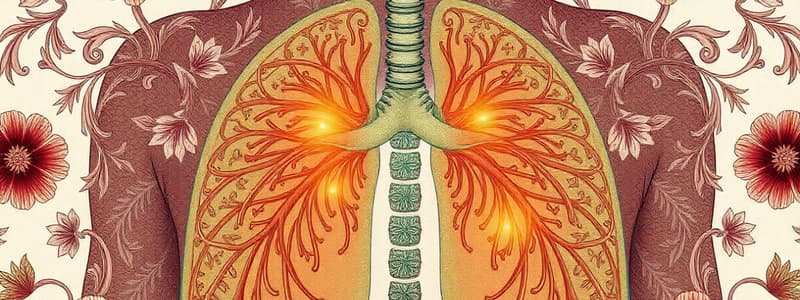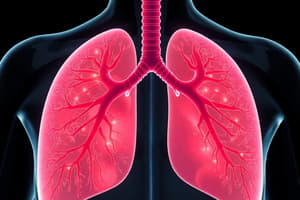Podcast
Questions and Answers
What is the role of cilia and mucus in the respiratory system?
What is the role of cilia and mucus in the respiratory system?
- They help regulate the temperature of the lungs.
- They help create a smooth surface for air to travel through.
- They help prevent dust particles and microorganisms from getting into the lungs. (correct)
- They help filter air and transport it to the lungs.
How does the body obtain extra oxygen during exercise?
How does the body obtain extra oxygen during exercise?
- The lungs receive more oxygen from the atmosphere.
- The body takes in more carbon dioxide, which converts to oxygen.
- The heart pumps faster, delivering more blood with oxygen to the muscles. (correct)
- The muscles create more oxygen through chemical reactions.
What happens to the depth of breathing during exercise?
What happens to the depth of breathing during exercise?
- It decreases, allowing for more efficient oxygen uptake.
- It remains the same, but the rate of breathing increases.
- It increases, allowing more air to be inhaled and exhaled. (correct)
- It fluctuates depending on the intensity of exercise.
What is the typical resting respiratory rate for a healthy adult?
What is the typical resting respiratory rate for a healthy adult?
What is the volume of air that moves in and out of the lungs at rest?
What is the volume of air that moves in and out of the lungs at rest?
What is the primary function of the alveoli in the lungs?
What is the primary function of the alveoli in the lungs?
Which of the following is NOT a key component of the breathing process?
Which of the following is NOT a key component of the breathing process?
What is the primary function of cilia in the respiratory system?
What is the primary function of cilia in the respiratory system?
How does the contraction of the external intercostal muscles affect the chest cavity?
How does the contraction of the external intercostal muscles affect the chest cavity?
What is the main difference between inhalation and exhalation?
What is the main difference between inhalation and exhalation?
How do gills in fish function similarly to alveoli in humans?
How do gills in fish function similarly to alveoli in humans?
What is the primary mechanism responsible for the movement of oxygen and carbon dioxide across the thin walls of alveoli and capillaries?
What is the primary mechanism responsible for the movement of oxygen and carbon dioxide across the thin walls of alveoli and capillaries?
Why do the alveoli and capillaries both have very thin walls?
Why do the alveoli and capillaries both have very thin walls?
What is the primary function of the lymphatic system?
What is the primary function of the lymphatic system?
Which of these structures helps prevent the trachea from collapsing when you exhale?
Which of these structures helps prevent the trachea from collapsing when you exhale?
Which of the following is NOT involved in the movement of lymph?
Which of the following is NOT involved in the movement of lymph?
Where in the lungs does gas exchange occur?
Where in the lungs does gas exchange occur?
Which of the following correctly describes the role of the diaphragm in breathing?
Which of the following correctly describes the role of the diaphragm in breathing?
Which of the following is NOT a key function of the lymphatic system?
Which of the following is NOT a key function of the lymphatic system?
Which of these statements about the lymphatic system is FALSE?
Which of these statements about the lymphatic system is FALSE?
What is the main difference between the lymphatic system and the circulatory system?
What is the main difference between the lymphatic system and the circulatory system?
Flashcards
Lymphatic System
Lymphatic System
A network of vessels that carry lymph around the body.
Lymph
Lymph
The fluid carried by the lymphatic system that contains lymphocytes.
Lymph Nodes
Lymph Nodes
Clumps of tissue that contain lymphocytes to fight infections.
Lymphocytes
Lymphocytes
Signup and view all the flashcards
Gas Exchange
Gas Exchange
Signup and view all the flashcards
Alveoli
Alveoli
Signup and view all the flashcards
Diaphragm
Diaphragm
Signup and view all the flashcards
Bronchi
Bronchi
Signup and view all the flashcards
Diffusion
Diffusion
Signup and view all the flashcards
Gills
Gills
Signup and view all the flashcards
Inhalation
Inhalation
Signup and view all the flashcards
Exhalation
Exhalation
Signup and view all the flashcards
Ciliated cells
Ciliated cells
Signup and view all the flashcards
Cilia
Cilia
Signup and view all the flashcards
Mucus
Mucus
Signup and view all the flashcards
Breathing Rate
Breathing Rate
Signup and view all the flashcards
Depth of Breathing
Depth of Breathing
Signup and view all the flashcards
Oxygen Demand
Oxygen Demand
Signup and view all the flashcards
Study Notes
Lymphatic System
- The lymphatic system is a network of vessels carrying lymph throughout the body.
- Lymph nodes are clumps of tissue containing lymphocytes, which fight pathogens.
- Lymph is a fluid carried by the lymphatic system.
- Lymph returns lymph to the blood.
- Lymph contains lymphocytes.
- Lymph fluid is not pumped but moved through the system by contractions of surrounding muscles and valves that ensure one-way flow.
- Lymph vessels collect fluid from tissues and blood capillaries.
- In lymph nodes, lymphocytes filter the lymph for pathogens.
Lungs and Breathing
- Lungs are part of the respiratory system for gas exchange.
- Air enters through the nose, trachea, bronchi and bronchioles.
- Gas exchange happens in the alveoli (tiny air sacs).
- Oxygen enters the bloodstream, and carbon dioxide leaves.
- Tough cartilage supports the trachea and prevents it from collapsing.
- Intercostal muscles and the diaphragm control breathing.
- Inhalation (breathing in) increases chest cavity volume lowering pressure, allowing air to enter.
- Exhalation (breathing out) reduces chest cavity volume increasing pressure, forcing air out.
- Cilia and mucus trap dust, preventing it from entering the lungs.
Gas Exchange
- Living organisms have gas exchange surfaces like lungs or gills.
- Alveoli (tiny air sacs) in lungs are the main gas exchange sites where oxygen diffuses into the blood and carbon dioxide diffuses out.
- Thin walls of alveoli and capillaries maximize gas diffusion.
- Fish have gills for gas exchange with filaments increasing surface area.
- Gas exchange occurs through diffusion.
Exercise and Breathing
- During exercise, breathing rate and depth increase to meet the higher oxygen demands of muscles.
- The volume of air breathed in and out (tidal volume) increases.
- Breathing rate increases to supply more oxygen and remove carbon dioxide.
- Breathing rate can be measured by counting breaths per minute; a typical resting rate is 12-18 breaths/minute for adults.
Studying That Suits You
Use AI to generate personalized quizzes and flashcards to suit your learning preferences.




